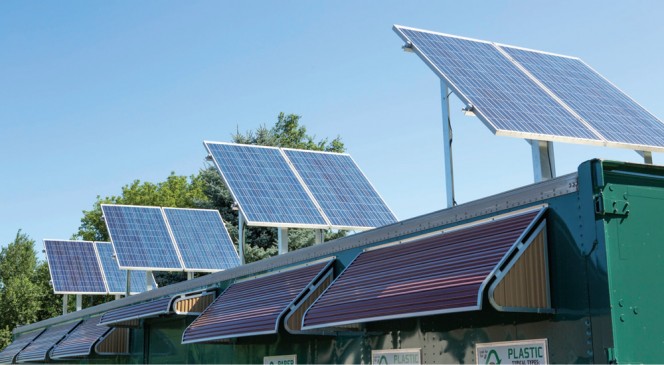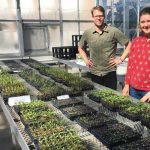BioCycle November 2015
First National Food Waste Reduction Goal: 50% By 2030
The U.S. Environmental Protection Agency (EPA) and U.S. Department of Agriculture (USDA) declared the first national food waste reduction goal at 50 percent by 2030. “Let’s feed people, not landfills,” stated EPA Administrator Gina McCarthy in announcing the goal. Noted USDA Secretary Tom Vilsack: “The United States enjoys the most productive and abundant food supply on earth, but too much of this food goes to waste.” To work towards the goal, the federal government will lead a new partnership with charitable and faith-based organizations, the private sector and local, state and tribal governments to reduce food loss and waste in order to improve overall food security and conserve the nation’s natural resources.
The US Composting Council (USCC), Natural Resources Defense Council (NRDC), National Foundation to End Senior Hunger (NFESH), World Wildlife Fund, Green Sports Alliance, Forum for the Future, Harvard Food Law and Policy Clinic, and the Johns Hopkins Bloomberg School of Public Health joined together to send a letter in support of the goal to the two agencies. The joint letter recommends EPA and USDA pursue several strategies to achieve the goal: Create database of baseline data; Support development of infrastructure and markets for composting and anaerobic digestion; Encourage more accurate quantification of food waste by businesses and federal agencies; and Create and lead a national implementation task force.
Preliminary data from research by ReFED, the “Rethink Food Waste Through Economics & Data,” show that the retail grocery, restaurant and institutional foodservice sectors of the food industry should be able to achieve a 25 to 30 percent reduction in food waste over the next 10 years. European nations have already adopted aggressive food scrap reduction goals. The ReFED Project process and outcomes will be presented in a session at the USCC’s COMPOST2016.
UK Food And Grocery Sector Beat The Goal
The food and grocery sector in the United Kingdom surpassed its waste reduction goal, according to the Waste and Resources Action Programme (WRAP), which released its second interim report of Courtauld Commitment 3 in late October. Signatories to the Commitment — more than 50 UK retailers, brands and manufacturers including Coca-Cola Enterprises, Unilever, AB InBev and Nestlé — have cut grocery ingredient, product and packaging waste in manufacturing and retail operations by 80,000 metric tons since 2012. In 2013, as part of the third phase of the Courtauld Commitment, the signatories committed to reducing food and drink waste by three percent, against a 2012 baseline. The report shows a 3.2 percent reduction. Carbon dioxide emissions associated with packaging show a sustained positive reduction in carbon dioxide emissions of 3.9 percent.
Sustainable Rural Recycling Prototype
Grand Valley State University in Grand Rapids, Michigan, in collaboration with Hastings Township, unveiled a prototype of a portable rural recycling center powered by renewable energy. The unit can be trucked to rural locations where curbside recycling pickup is not cost-efficient, as well as places where a central transfer station is too far away for some residents to make the trip. “What we’ve put together, in partnership with Hastings Township officials, is a portable recycling center that can be duplicated and placed in rural and remote locations,” explains Nick Baine, assistant professor of engineering at Grand Valley. “It’s efficient because it runs on solar power and recycled batteries, and minimizes operational costs because township staff can use remote cameras to see exactly when the recycling bins need to be emptied.”
The prototype is essentially a used semitrailer; windows and doors were cut into the sides to allow for recyclable materials to be dropped off. It has four solar panels installed on the roof. The panels enable the center to be completely self-sufficient so it can be placed in spaces where there are no power lines. The solar panels send power through a system to the bank of batteries inside the unit, which allows lights and security systems to continue to work at night or on cloudy days. The power bank is made of post-vehicle-application lithium-ion batteries, which are commonly found in newer hybrid and electric vehicles, and can power the recycling center for up to three days without sunshine. Grand Valley’s Michigan Alternative and Renewable Energy Center, or MAREC, was also part of the project.
Strategic Plan For EPA’s SMM Program
The U.S. EPA released its new Sustainable Materials Management Program (SMM) Strategic Plan for fiscal years 2017 through 2022. This strategic plan represents the collective thinking of EPA staff and management across the country, as well as input from many stakeholders including states, industry and nongovernmental organizations. “The life-cycle based decision-making and systems-based approaches of SMM reflected in this strategic plan offer far greater opportunities for addressing the complex environmental issues we face today than traditional resource, waste and chemicals management approaches,” explains Mathy Stanislaus, Assistant Administrator for EPA’s Office of Solid Waste & Emergency Response. “SMM truly represents a change in how we think about environmental impacts and economic opportunities.”
The plan focuses on three main strategic priorities that present significant opportunities to achieve environmental, economic, and social results:
The Built Environment — Conserve materials and develop community resiliency to climate change through improvements to construction, maintenance, and end-of-life management of the nation’s roads, buildings, and infrastructure.
Sustainable Food Management — Focus on reducing food loss and waste.
Sustainable Packaging — Increase the quantity and quality of materials recovered from MSW and develop critically important collection and processing infrastructure.
“In addition to these strategic priorities, we will continue work in our other SMM emphasis areas including sustainable electronics management, materials measurement, life cycle assessment, and SMM international efforts,” adds Stanislaus.











